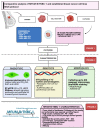MFUM-BrTNBC-1, a Newly Established Patient-Derived Triple-Negative Breast Cancer Cell Line: Molecular Characterisation, Genetic Stability, and Comprehensive Comparison with Commercial Breast Cancer Cell Lines
- PMID: 35011679
- PMCID: PMC8749978
- DOI: 10.3390/cells11010117
MFUM-BrTNBC-1, a Newly Established Patient-Derived Triple-Negative Breast Cancer Cell Line: Molecular Characterisation, Genetic Stability, and Comprehensive Comparison with Commercial Breast Cancer Cell Lines
Abstract
Triple-negative breast cancer (TNBC) is a breast cancer (BC) subtype that accounts for approximately 15-20% of all BC cases. Cancer cell lines (CLs) provide an efficient way to model the disease. We have recently isolated a patient-derived triple-negative BC CL MFUM-BrTNBC-1 and performed a detailed morphological and molecular characterisation and a comprehensive comparison with three commercial BC CLs (MCF-7, MDA-MB-231, MDA-MB-453). Light and fluorescence microscopy were used for morphological studies; immunocytochemical staining for hormone receptor, p53 and Ki67 status; RNA sequencing, qRT-PCR and STR analysis for molecular characterisation; and biomedical image analysis for comparative phenotypical analysis. The patient tissue-derived MFUM-BrTNBC-1 maintained the primary triple-negative receptor status. STR analysis showed a stable and unique STR profile up to the 6th passage. MFUM-BrTNBC-1 expressed EMT transition markers and displayed changes in several cancer-related pathways (MAPK, Wnt and PI3K signalling; nucleotide excision repair; and SWI/SNF chromatin remodelling). Morphologically, MFUM-BrTNBC-1 differed from the commercial TNBC CL MDA-MB-231. The advantages of MFUM-BrTNBC-1 are its isolation from a primary tumour, rather than a metastatic site; good growth characteristics; phenotype identical to primary tissue; complete records of origin; a unique identifier; complete, unique STR profile; quantifiable morphological properties; and genetic stability up to (at least) the 6th passage.
Keywords: MCF-7; MDA-MB-231; MDA-MB-453; MFUM-BrTNBC-1; breast cancer cell lines; hormonal receptors; triple-negative breast cancer.
Conflict of interest statement
The authors declare no conflict of interest.
Figures






References
-
- The WHO Classification of Tumours Editorial Board, editor. Breast Tumors. 5th ed. International Agency for Research on Cancer; Lyon, France: 2019.
-
- Núñez Abad M., Calabuig-Fariñas S., Lobo de Mena M., José Godes Sanz de Bremond M., García González C., Torres Martínez S., García-García J.Á., Iranzo González-Cruz V., Camps Herrero C. Update on systemic treatment in early triple negative breast cancer. Ther. Adv. Med. Oncol. 2021;13:1758835920986749. doi: 10.1177/1758835920986749. - DOI - PMC - PubMed
Publication types
MeSH terms
Grants and funding
LinkOut - more resources
Full Text Sources
Research Materials
Miscellaneous

